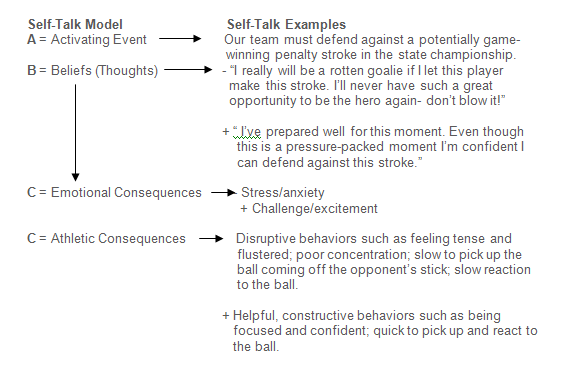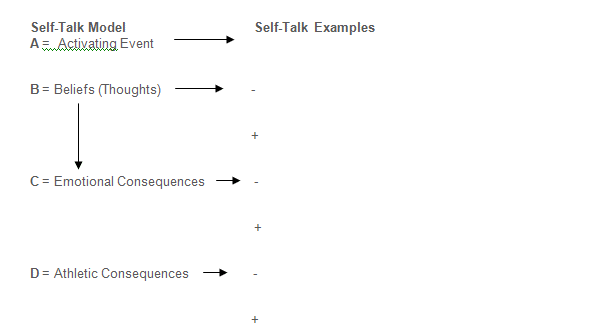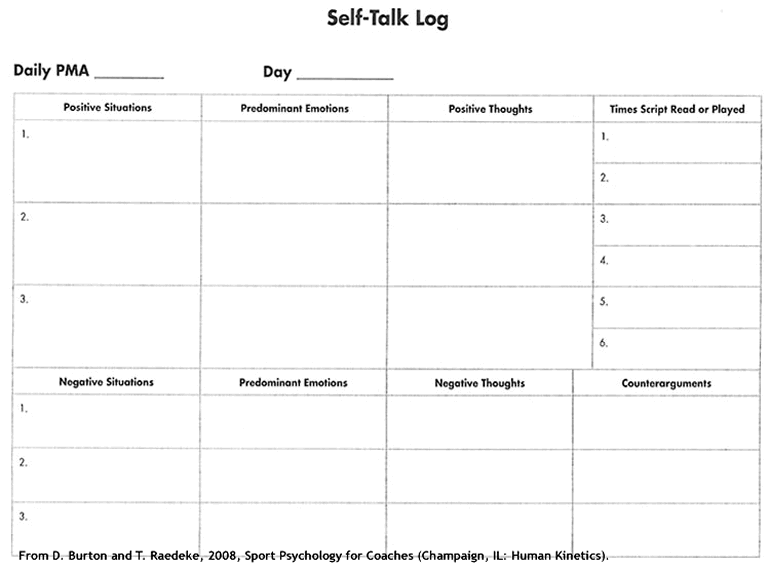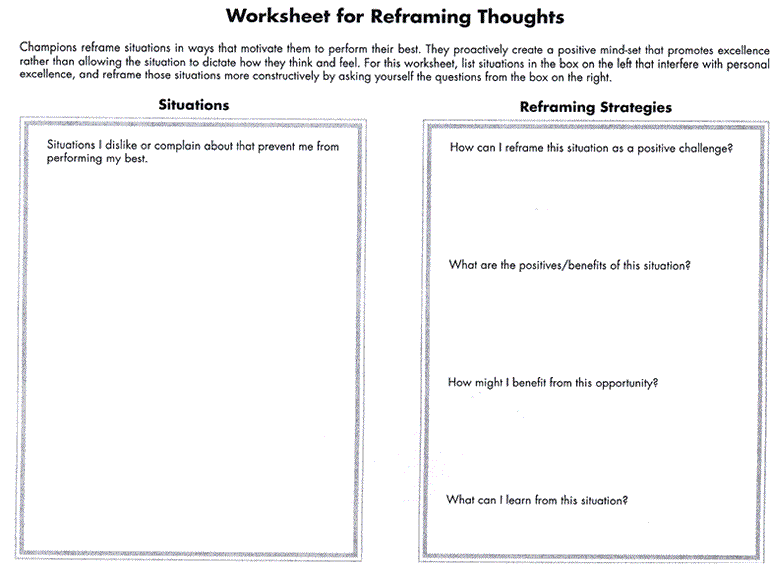 Psychological
Skills Training: Self-Talk Skills Psychological
Skills Training: Self-Talk Skills
written by Dr.
Christine Lottes
Psychological Skills
Training series: previous issues
- TRAINING
YOUR ATHLETES TO BE MENTALLY TOUGH
- MENTAL
TRAINING TOOLS
- GOAL
SETTING AND SELF-CONFIDENCE
- IMAGERY
- PSYCHOLOGICAL
SKILLS TRAINING: RELAXATION AND ENERGIZATION
Athletes' thoughts can either enhance or hinder performance.
Continuing our Psychological Skills Training series in pelinks4u,
today's article provides a script for the coach and 2 reproducible
handouts (one a script for the coach plus a handout for athletes).
We will look at how athletes can successfully manage their
self-talk.
Coach’s Script for: Self-Talk Skills
Bring to practice: coach's script, a copy of the athlete's
handout for each athlete (follows the coach's script), pencils
or pens, chalk.
SELF-TALK
This lesson will take two hours. It can be broken up into
2 different sessions.
Review:
- Relaxation means decreasing unwanted
muscular tension & calming the mind.
- Total relaxation
is a longer strategy that helps athletes relax completely.
Rapid relaxation is an abbreviated technique
that uses a cue word to relax quickly.
- Relaxation includes deep breathing,
imagery, relaxation, muscle relaxation
and cue words.
- Energization
helps athletes control arousal, enhance concentration and
elevates confidence, particularly when they are tired, encountering
adversity, or dealing with low energy levels.
- Energization includes psych-up
breathing, imagery energization, muscle activation and cue
words.
- The cued words are associated
with feelings of high energy, and in rapid energization
can occur in 3-5 seconds.
Check-up from First Session:
- Look in your notes from the end of our first session
where you listed an action you'd take to deal with something
you were concerned about. Did you do it? Volunteers to share.
Continue with taking action with things you can control.
Today: Self-Talk
- Self-talk is the steady stream of thoughts and internal
dialogue that goes on in our heads almost constantly. Your
thoughts have a major impact on your mood, emotions and
performance.
- Make a list of thoughts you had
so far today:
- _______________________________________________________
- _______________________________________________________
- _______________________________________________________
- To make self-talk work for you,
you want to increase positive thoughts
and decrease negative thoughts as your
thoughts will affect your sport performance and all other
areas of your life.
- Positive self-talk leads to a
flow mind-set in which you will excel athletically.
- Negative self-talk leads to a
choking mind-set in which irrational thoughts
can cause you to underachieve.
- When an event happens to you,
you have beliefs about the situation - how you interpret
what has happened. This interpretation of the situation
determines your emotions and behavior to a much greater
extent than does the situation itself.
- Let's look at an example of this.
(Coach, you can rewrite this for your sport....)

Depending on the age of your athletes, either do the following
together as a team or have each athlete complete his/her own.
If completed individually, take them home and check them over,
make corrections, etc.

- The basic principle of self-talk is that we can't always
control what happens to us, but we can control how we respond
to uncontrollable events.
- Our self-talk comes from either
positive or negative thinking.
- Positive thoughts help
performance while negative thoughts hurt
performance.
- We'll call positive thought patterns
smart-talk.
- Eight rules of smart-talk
- Be an optimist, not a
pessimist: self-talk is a choice.
Focus on what you can control, not on what you can't.
- Remain realistic and objective:
make goals you can achieve.
- Focus on the present,
not the past or future: it is the only thing you
can control.
- Appraise problems as challenges
rather than threats: this keeps you motivated and
performing up to your capabilities.
- View successes as replicable
and failures as surmountable: view success as due
to ability and effort.
Attribute failure to factors you can control such
as effort level (I'll work harder next practice),
skill development (I can learn to read my opponent
better) and mental preparation (next time I'll improve
my focus).
- Concentrate on process,
not outcome: focus self-talk on
process goals - hard work, mental preparation, skill
and strategy development - that you can control
and will lead to outcome goals. Ex. In the seconds
before the penalty corner concentrate on "stopping
the ball and follow-through on the shot" or
"explode out, stick-to-stick" or "explode
out, set, ball" or "explode back (from
50) and into position." (NOTE to Coach: Change
this to line up with the Self-Talk Model you revised
for your sport.)
- Concentrate on things
you can control: Can't control
people and some events (opponent's behavior, officials'
decisions, playing conditions). Can control your
emotions and behavior.
- Separate your performance
from your self-worth: Your worth
has nothing to do with how you perform. It has everything
to do with who you are as a unique creation who
is loved regardless of your performance.
- Negative Thought Patterns: watch for distorted
thinking and irrational beliefs.
- Distorted Thinking:
catastrophizing (expecting the worst and exaggerating the
consequences), over-generalization (just because you make
a mistake you think that you always mess up), blaming (holding
others responsible for negative events in my life), mustification
(things must be my way) and polarized thinking (one way
or another- I'm a success or a failure).
- Irrational Beliefs:
perfectionism (I have to never make mistakes), fear of failure
(some failure is normal), social approval (everyone must
like me), equity (life must be fair, I should play well
and get the rewards I deserve if I work hard) and social
comparison (putting too much importance on largely uncontrollable
outcomes, such as winning and outperforming others rather
than concentrating on controllable factors such as playing
your best.)
- Optimizing Self-Talk:
- Awareness of current self-talk patterns
- Imagery
recall: Close eyes and think about a competition
that you played very well. Now write down some specific
thoughts you had during the competition that helped
you succeed. Now think about a poor performance.
Now write down your thoughts during that competition.
Compare the two lists and identify positive and
negative self-talk patterns that most affect your
performance. Use Self-Talk Log.
- Negative Thought Counts:
On your own- Put a number of paper clips, pennies
or sunflower seeds in a pocket, Each time you catch
yourself using a negative thought, move one item
to a different pocket.
- Goal
is for negative thoughts to decrease.
- Post practice and Competition
Logs - see me if want to work on this area more and
I'll set this up for you. See below for Positive Mental
Attitude Self-Talk Log.
- Program Positive
Thoughts: increases confidence, improves concentration
and focus, enhances motivation, controls stress and
so increases performance.

- Positive affirmations: I'm a talented athlete with the
skills to get the job done.
- Team mottos or Motivational
slogans: "Footwork is the key to success." "Suffocating
defense." "No less than all."
- Cue words:
"relax," "ball," "one play at a
time," "I play well every time I take the field,"
" smooth swing," "stick with what's working,"
"hustle." (Coach, you can rewrite these for your
sport...)
- Reframe Negative Thinking:
Negative thoughts will still occur and can lead to negative
emotions and sub par performance. To correct them follow
the "3 Ds" of reframing:
- Detect
negative, unproductive or irrational thinking: what
was the thought that preceded feelings
of stress or other negative emotions?
- Disrupt
negative thoughts by either thought
stopping or thought changing: Say
"Stop" and think of a red stop sign, red
flag or flashing red lights. Or, use a behavioral
cue - snap finger or snap a rubber band when have
a negative thought. Thought changing works like
a TV remote control to simply change the channel
from one with negative thoughts to another that
is more positive and productive.
- Dispute negative thoughts
by using effective counter-arguments. They function
like a good lawyer, putting faculty beliefs on trial,
refuting them with logical arguments and identifying
logical, realistic, productive thoughts to take
their place. Ex. I want more playing time and I
worry that my coach doesn’t like me. A counterargument
will reduce my anxiety- “I can’t control
what my coach thinks or how much she decides to
play me. I need to concentrate on what I can control
and play my best by focusing on footwork and positioning
when I don’t have the ball.” (Coach,
you can rewrite this for your sport...)
- Do Worksheet for Reframing Thoughts.
 Adapted,
by permission, from K. Ravizza and T. Hanson, 1995, Heads
up baseball: Playing the game one pitch at a time (Indianapolis,
IN: Masters Press), 3d, by permission of the McGraw-Hill Companies.
From D. Burton and T. Raedeke, 2008, Sport Psychology
for Coaches (Champaign, IL: Human Kinetics). Adapted,
by permission, from K. Ravizza and T. Hanson, 1995, Heads
up baseball: Playing the game one pitch at a time (Indianapolis,
IN: Masters Press), 3d, by permission of the McGraw-Hill Companies.
From D. Burton and T. Raedeke, 2008, Sport Psychology
for Coaches (Champaign, IL: Human Kinetics).
- Develop a self-talk script:
|
Smart-Talk Script Development Form
Directions: Step 1 is to identify
the purposes of your smart-talk script. Look at the
accompanying Purposes and Thoughts for Smart-Talk Scripts
(figure 7.4) and select one or more of the seven purposes
for developing a self-talk script. Write each of the
purposes you choose on a separate section of this forms
(i.e., write your first purpose in Section 1, your second
purpose in Section 2, etc). Step 2
is to study the form and select one or more specific
thoughts to convey each purpose and record them under
the Specific Thoughts that correspond to each purpose.
Sample thoughts are listed for each purpose, but you
may also make up your own thoughts or borrow them from
other sources. Step 3 is to number
the specific thoughts in each section in the order that
maximizes the flow of your script and strengthens its
impact. Place a numerical ranking selecting the order
you want thoughts listed on your script inside the parentheses
provided at the beginning of each thought. Step
4 is to reorder each section to create ideal
flow for your script and heighten its impact by placing
a ranking inside the parentheses at the beginning of
each purpose. Finally, develop a catchy introduction
and powerful conclusion that will maximize the effectiveness
of your smart-talk script.
Example:
Purpose (1) Reminders of strengths and assets
Specific Thoughts:
(1) I have the ability, dedication, and work ethic to
excel in whatever I do.
(2) I am a talented person with skills and abilities
that allow me to be successful in life.
Section 1 Purpose (1) ___________________________________
Section 1 Specific Thoughts:
(1) __________________________________________________________
(2) __________________________________________________________
(3) __________________________________________________________
(4) __________________________________________________________
(5) __________________________________________________________
Section 2 Purpose (2) ___________________________________
Section 2 Specific Thoughts:
(1) __________________________________________________________
(2) __________________________________________________________
(3) __________________________________________________________
(4) __________________________________________________________
(5) __________________________________________________________
Section 3 Purpose (3) ___________________________________
Section 3 Specific Thoughts:
(1) __________________________________________________________
(2) __________________________________________________________
(3) __________________________________________________________
(4) __________________________________________________________
(5) __________________________________________________________
Section 4 Purpose (4) ___________________________________
Section 4 Specific Thoughts:
(1) __________________________________________________________
(2) __________________________________________________________
(3) __________________________________________________________
(4) __________________________________________________________
(5) __________________________________________________________
Section 5 Purpose (5) ___________________________________
Section 5 Specific Thoughts:
(1) __________________________________________________________
(2) __________________________________________________________
(3) __________________________________________________________
(4) __________________________________________________________
(5) __________________________________________________________
Catchy Introduction: _______________________________________________________________________________
________________________________________________________________________________________________
Powerful Conclusion: _______________________________________________________________________________
________________________________________________________________________________________________
From D. Burton and T. Raedeke, 2008, Sport Psychology
for Coaches (Champaign, IL: Human Kinetics). |
Purposes and Thoughts for Smart-Talk Scripts
Directions: Select the main purpose for
your smart-talk script from section 1. You may select one
purpose, all seven, or any number in between. Next, for each
purpose, select from section 2 any of the specific thoughts,
affirmations, or counter-arguments that convey the nature
of that purpose for you. You can also use your own thoughts
or borrow ideas from other sources. Write a smart-talk script
based on these thoughts.
Section 1: Purposes for Script Development
- Remind yourself of your assets, strengths, and desirable
personal qualities.
- Establish priorities and goals
as well as action plans for how to achieve them.
- Recall past successes, particularly
in similar situations or when overcoming obstacles, failure,
or adversity.
- Emphasize the quantity and quality
of your preparation.
- Appraise all situations as challenges
rather than threats and implement effective problem-solving
strategies.
- Reframe negative thoughts.
- Attribute success to hard work
and improving ability and failure to internal/controllable/unstable
factors such as the need to try harder, to improve your
mental preparation, or to develop your skills more fully.
Section 2: Sample Positive Thoughts, Affirmations, and Counter-arguments
1. Reminders of Assets,
Strengths, and Desirable Personal Qualities
- I'm a talented person with skills and abilities that allow
me to be as successful as I want to be in life.
- Ultimately I'll be judged by who
I am, not by what I accomplish.
- I have the ability to make myself
into a better performer who can help my team in many ways.
- I have rich, rewarding relationships
with my close friends and family.
- I like who I am and enjoy being
me. I like the person I see in the mirror.
2. Priorities and Goals
Plus Action Plans to Achieve Them
- I have a dream or vision of what I want in life
- I have set my goals, established
my priorities, and developed action plans to make them a
reality.
- Dreams become reality through hard
work and sacrifice.
- I have the time, energy, and wisdom
to accomplish all my goals.
- This is a "can do," "will
do," and "get things done" day.
3. Remember Past Successes
in Similar Situations or How You Overcome Adversity
- I have been very successful in similar situations in the
past.
- I have overcome difficult obstacles
in the past and I can do it again.
- Failure makes me stronger by helping
to identify areas where I need to improve.
- I know it's only a matter of time
until my hard work pays off and I become successful.
- Overcoming failure and adversity
requires a commitment to work even harder and an effective
plan to get better and eliminate my weaknesses.
4. Recall the Quantity
and Quality of Preparation
- Nobody works harder than I do, and at crunch time, I'll
be in better condition and more willing to pay the price
than my opponent.
- My physical, mental, and technical
and tactical training were carefully designed to prepare
me perfectly to excel in this competition.
- My coach has taught me to understand
my opponent's game and to counter these tactics successfully.
- I have prepared myself well to
maximize my strengths and minimize my weaknesses.
- I get a little bit better every
day in practice and move a step closer to being the best
I can be.
5. Appraise Situations
as Challenges, Not Threats, and Problem-Solve Effectively
- Everyone encounters failure and adversity. Champions rise
above adversity by viewing problems as opportunities for
excellence.
- I recognize that mistakes are a
normal part of learning. As long as I'm learning and trying
to get better, mistakes are inevitable. I will look at each
mistake as an opportunity to learn and grow as I strive
for excellence.
- I will approach each problem as
a challenge - an opportunity to learn and get better as
a person and as an athlete.
- No matter how bleak the outlook
or how difficult the obstacle, I will accept the challenge
to perform my best and come up with a strategy that will
allow me to be successful.
- I take constructive criticism well,
using that feedback to make myself a better person and athlete.
6. Reframe Negative Thoughts
- I'll concentrate on doing my best right now because I
can't change what has happened in the past or what may happen
in the future. All I can do is strive for excellence at
this moment.
- I accept what I can't change or
control. I can't control what others think of me or how
they play. I can't control my God-given ability or how fast
I learn skills. I can't control official's decisions, playing
conditions, or luck. I can control my own effort level,
attitude, mood, and performance. I'll concentrate on what
I can control and not worry about what I cannot control.
- Life is often unfair, and that
is OK. I will continue to work hard because persistence
pays off in the long run.
- I can't control what others think
and how they behave. people can find fault with even Hall-of-Fame
performers. i will strive to please myself and enjoy competing.
The person I have to answer to is the one in the mirror.
- Playing poorly is disappointing
but not awful or unbearable. My life will go on, even if
I don't play well. I will try to learn from my mistakes
so that I can be more successful in the future.
7. Attribute Success to
Hard Work, and Failure to Low Effort or the Need to Develop
Skills
- Working hard and developing my skills will allow me to
continue to achieve success as I progress up the competitive
ladder.
- I know my hard work and consistent
practice have paid dividends and allowed me to achieve the
success I've had.
- This failure is temporary and can
be overcome with hard work and persistent skill development.
- All failure is surmountable with
enough time, patience, hard work, and careful planning.
- When confronted with failure, I
focus on the things I can control such as trying harder,
getting better prepared mentally, developing my skills more
fully, and enjoying the opportunity to test my skills.
From D. Burton and T. Raedeke, 2008, Sport Psychology
for Coaches (Champaign, IL: Human Kinetics)
- Read your script, or record it and play it 4-5 times
per day. Prime times to read or play scripts include first
thing in the morning, last think at night, on the way to
class, during study breaks, and before and after practice.
- When a negative thought occurs,
remember the three Ds of the reframing process: Detect,
Disrupt and Dispute each
negative thought and replace it with one that is more positive
and productive. Refer to chart of Self-Talk Dos and Don'ts.
- Keep a list of negative situations
they have difficulty reframing. Several times a week intensely
imagine one and the corresponding negative
emotions before using reframing skills to counter faulty
thinking. Can build counter-arguments for situations that
are particularly problematic into their smart-talk scripts.
- When utilizing Self-Talk in practice
or games, here as some helpful "Dos and Don'ts."
Self-Talk Dos and Don'ts
Dos |
Don'ts |
|
BEFORE PRACTICE OR COMPETITION |
| Focus on positive self-perceptions and
strengths |
Don't focus on negative self-perceptions
and weaknesses |
| Focus on your effective preparation |
Don't focus on inadequacy of or problems
with preparation |
| Remind yourself of previous successes |
Avoid thinking about previous failures |
| Focus on positive expectations and goals |
Avoid unrealistic expectations and negative
goals |
| Reframe any irrational beliefs using
effective counter-arguments |
Don't allow irrational beliefs to go
unchallenged |
|
DURING PRACTICE OR COMPETITION |
| Limit thinking and rely on automated
skills |
Don't think too much, over-analyze, or
try to make it happen |
| Focus on the present, not the past or
future |
Don't dwell on past mistakes or potential
future problems |
| Focus on process, not product, using
effective cue words |
Avoid thinking about the products too
much |
| Appraise the situation as a challenge
and maintain positive expectations and goals |
Don't appraise the situation as a threat |
| Reframe negative thoughts, and use effective
problem solving strategies |
Avoid haphazard reframing or unsystematic
problem solving |
|
FOLLOWING PRACTICE OR COMPETITION |
| Attribute success to internal, controllable
factors such as effort and mental prep that will increase
perceived competence |
Don't attribute success to external factors
or failure to stable, internal ones that will reduce perceived
competence |
| Develop positive future expectations
and goals, complete with action plans for how to achieve
them, and minimize oversights |
Avoid negative expectations and goals |
From D. Burton and T. Raedeke, 2008, Sport Psychology
for Coaches (Champaign, IL: Human Kinetics)
Summary
- Self-talk is the steady stream of thoughts and internal
dialogue that goes on in our heads almost constantly. Your
thoughts have a major impact on your mood, emotions and
performance.
- The ABCs of self-talk describe
how thoughts affect emotions and behaviors. A= activating
event; B= your belief or interpretation of the situation
and it determines your emotions and behavior to a much greater
extent than the situation itself does; C= is the consequence
- how you feel and act afterward.
- Successful self-talk requires
recognizing and changing negative thoughts.
- You can combat distorted and
irrational thinking by using counter-arguments to reframe
your thoughts.
- The best way to program positive
self-talk is to develop a short, smart-talk script and read
or play it 4-5 times daily.
- To reframe a negative thought
use the three Ds - detecting, disrupting, and disputing
negative thoughts.
Upcoming June/July article on Mental Training
In the June/July edition of pelinks4u we will be
discussing energy management. Energy Management utilizes either
relaxation or energization (see December
issue of pelinks4u for how to train athletes
in relaxation/energization) to get into an optimal energy
zone for practice and competition. A script for the coach
and a reproducible handout for athletes will be provided.
Coaches:
Download this Article Here!
Download
Athletes Handout Here!
(back
to pelinks4u homepage) |




 Psychological
Skills Training: Self-Talk Skills
Psychological
Skills Training: Self-Talk Skills


 Adapted,
by permission, from K. Ravizza and T. Hanson, 1995, Heads
up baseball: Playing the game one pitch at a time (Indianapolis,
IN: Masters Press), 3d, by permission of the McGraw-Hill Companies.
From D. Burton and T. Raedeke, 2008, Sport Psychology
for Coaches (Champaign, IL: Human Kinetics).
Adapted,
by permission, from K. Ravizza and T. Hanson, 1995, Heads
up baseball: Playing the game one pitch at a time (Indianapolis,
IN: Masters Press), 3d, by permission of the McGraw-Hill Companies.
From D. Burton and T. Raedeke, 2008, Sport Psychology
for Coaches (Champaign, IL: Human Kinetics).